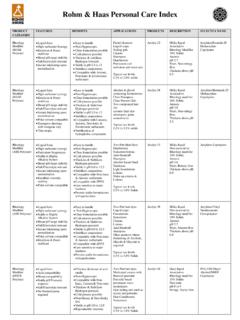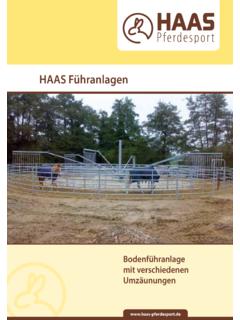Transcription of Drilling Like There's No Tomorrow ... - …
1 EI @ haas WP 254. Drilling Like There's No Tomorrow : bankruptcy , insurance , and environmental risk Judson Boomhower Revised March 2016. Energy Institute at haas working papers are circulated for discussion and comment purposes. They have not been peer-reviewed or been subject to review by any editorial board. 2016 by Judson Boomhower. All rights reserved. Short sections of text, not to exceed two paragraphs, may be quoted without explicit permission provided that full credit is given to the source. Drilling Like There's No Tomorrow : bankruptcy , insurance , and environmental risk Judson Boomhower.
2 March 5, 2016. Abstract This paper measures the effects of bankruptcy protection on industry struc- ture and environmental outcomes in oil and gas extraction. Using administra- tive data from Texas, I exploit variation in an insurance requirement that re- duced firms' ability to avoid liability through bankruptcy . Among small firms, the policy substantially improved environmental outcomes and reduced pro- duction. Most production was re-allocated to larger firms with better environ- mental records, but high-cost production where social cost may have exceeded social benefit decreased.
3 These results suggest that incomplete internalization of environmental costs due to bankruptcy is an important determinant of in- dustry structure and safety effort in hazardous industries. Stanford Institute for Economic Policy Research (SIEPR). Email: I am grateful to Severin Borenstein, Lucas Davis, Meredith Fowlie, Max Auffhammer, Catherine Wolfram, Ryan Kellogg, Hunt Allcott, Reed Walker, Charlie Kolstad, Derek Lemoine, Walter Graf, Pat Baylis, and Paula Pedro; to seminar participants at the NBER Summer Institute, EI at haas Energy Camp, Carnegie Mellon, Chicago Harris, Columbia SIPA, Michigan, Northwestern Kellogg, Stanford, UBC, UC Davis, UC San Diego, and UC Santa Barbara; and to the Railroad Commission of Texas.
4 Research support from a National Science Foundation Graduate Research Fellowship and the Energy Institute at haas is gratefully acknowledged. In almost all legal systems the debts of insolvent parties can be eliminated through bankruptcy . bankruptcy protection improves insolvent actors' work incentives and mitigates coordination problems among creditors. However, bankruptcy protection also distorts behavior by insulating actors from worst-case outcomes. For example, financial firms may become excessively leveraged or consumers may accumulate excessive personal debt.
5 One important implication of bankruptcy protection is that firms in hazardous industries will take excessive environmental and public health risks . Since damages can be discharged in bankruptcy , firms with assets less than their worst-case liabilities face inadequate safety incentives. Economists call this the judgment-proof problem (Shavell, 1986). In addition to reducing precaution in the short run, the judgment-proof problem may also distort industry structure. The ability to avoid liability through bankruptcy creates a private cost advantage for small firms, potentially shifting production away from larger producers with lower social costs of production.
6 This paper measures the effect of bankruptcy protection on environmental outcomes and industry composition in the onshore oil and gas industry. Motivated by stylized facts about hazardous industries, I propose a simple conceptual model of an indus- try with heterogeneous projects ( , oil wells) and firms. bankruptcy protection lowers the expected private costs of environmental damage for small producers. As a result, small firms exercise too little care in each project; acquire some projects that would be efficiently operated by large firms; and develop additional high-cost projects where social cost exceeds social benefit.
7 I test the predictions of this model using data on the universe of onshore oil and gas producers in Texas. The analysis draws on several administrative databases 1. covering production, environmental outcomes, and entry and exit. To identify the effects of the judgment-proof problem, I exploit quasi-experimental variation in in- surance requirements stemming from the introduction of a surety bond mandate during 2002 2003. A surety bond is an insurance contract that obligates the in- surer to pay the state for environmental costs left over if the insured firm becomes insolvent.
8 Requiring bonds causes firms to internalize a greater share of expected environmental costs through the ongoing premiums they pay to insurers. I find that the bond requirement caused striking changes in industry structure. About 6% of producers left the market immediately. These exiting firms were small and had poor environmental records. Among remaining firms, the bond requirement reduced production among the smallest 80% of firms by about 5% on average. Most of the oil and gas wells affected by these exits or reductions were acquired by large firms that continued operating.
9 However, there was a reduction in very low-producing wells, where social cost (including environmental risk) may exceed social benefit. environmental outcomes also improved sharply. I find clear evidence of an 85%. decrease in firms leaving wells unplugged at the end of production (which creates a serious risk of groundwater pollution). There were also substantial decreases in inspection violations and well blowouts coincident with the implementation of the policy. The improvements were concentrated among small firms. This group also had the highest rates of environmental incidents prior to the policy change.
10 The results suggest that by screening out firms that insurers perceived to be high-risk, and increasing accountability for remaining firms, the bond requirement mitigated the harmful incentive effects created by bankruptcy protection. 2. As I discuss in Section 2, the empirical literature about the judgment-proof problem in hazardous industries is limited. This paper contributes to that literature in four ways. First, existing studies have focused on a single margin, such as accidents (Alberini and Austin, 2002) or firm size (Ringleb and Wiggins, 1990). This paper leverages project- and firm-level data on both industry composition and environ- mental outcomes to provide a comprehensive investigation of the judgment-proof problem in a single industry.











